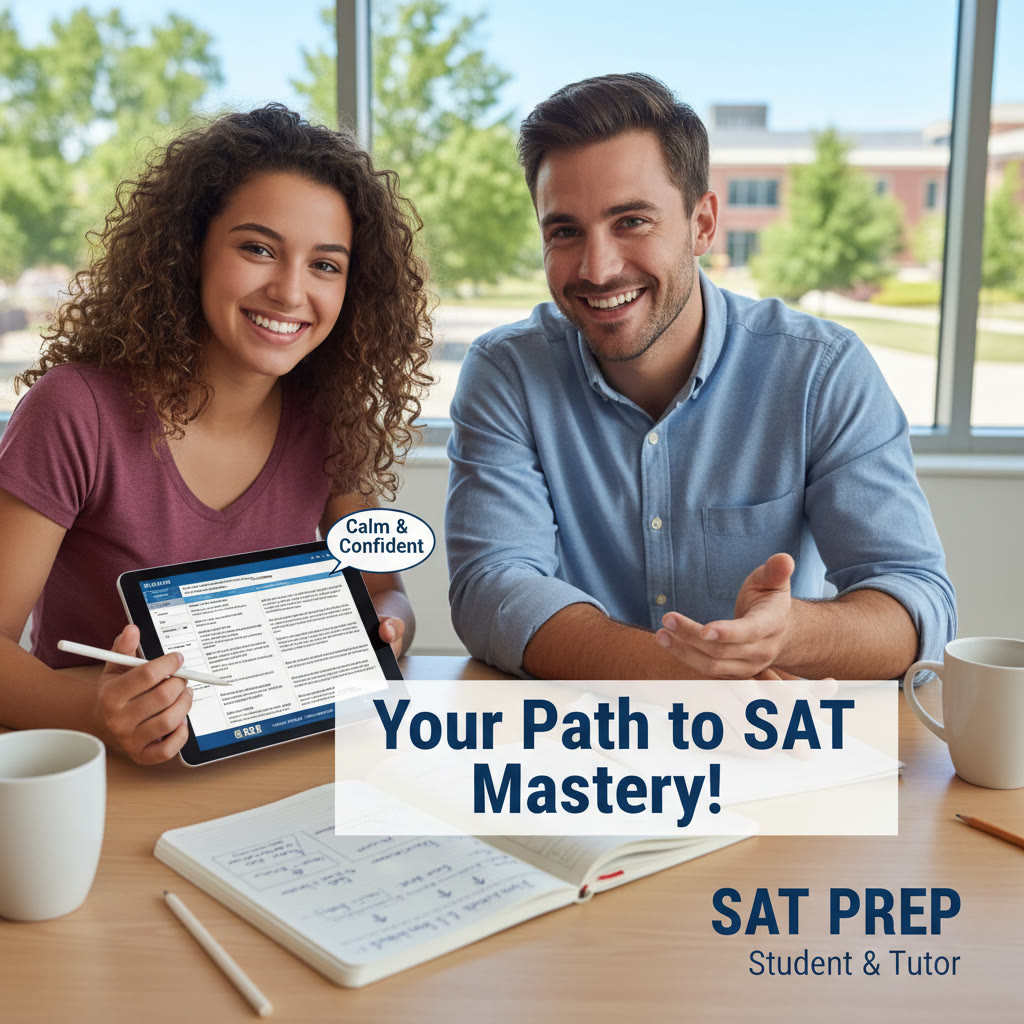Why Balance in Daily Routines Improves SAT Prep
There’s a familiar scene: the late-night cram session, coffee cups piled up, practice tests stacked like trophies, and a brain that feels a little fried. For many students, that image is presented as the default path to SAT success. But there’s a quieter, more reliable route that gets excellent results without the exhaustion: balance. When you design a daily routine that mixes focused study, rest, movement, and real-life joy, your learning becomes deeper, your practice more efficient, and test-day nerves easier to manage.

What balance really means for SAT prep
Balance is not a perfectly even split of time between studying and leisure. It’s about aligning high-quality study with recovery and life responsibilities so that the work you do sticks. A balanced routine for SAT prep typically includes:
- Consistent sleep (enough for your age),
- Focused study blocks with clear goals,
- Regular breaks and movement to reset concentration,
- Nutrition and hydration that support cognitive performance,
- Time for social connection, hobbies, and stress management.
When these pieces fit together, practice becomes practice—not busywork—and your brain consolidates and applies what you learn instead of letting it slip away.
Why balance helps: the science in plain language
There’s a simple reason balanced routines work: learning depends on more than just time on task. Several mechanisms make balance powerful:
- Sleep consolidates memory. During sleep, your brain strengthens memories and transfers knowledge into long-term storage. For most teenagers, 8 to 9 hours is ideal; adults typically need 7 to 9 hours. Skimping on sleep reduces retention and problem-solving ability.
- Spaced repetition beats massed practice. Studying the same material repeatedly with intervals in between leads to better long-term retention than cramming the same amount of time in one night.
- Breaks reduce cognitive fatigue. Focused attention depletes quickly; short, regular breaks (for example, a quick walk or a snack) restore attention and improve productivity.
- Physical activity helps executive function. Even a 20-minute brisk walk raises blood flow to the brain and boosts mood and concentration—perfect for turning a study slump around.
- Stress and nutrition matter. Chronic stress increases cortisol, which can impair working memory. Balanced meals and hydration support steady energy and focus during study sessions and tests.
Cramming vs balanced routine: a practical comparison
Imagine two students aiming for the same SAT score. Maya spreads her study over eight weeks: she does focused practice five days a week, takes full-length tests every two weeks, sleeps consistently, and fits in short workouts. Alex studies in blocks of marathon sessions right before the test, pulling several late nights a week. Which approach is likely to produce a higher, more reliable score?
Maya’s routine gives her multiple advantages: she encounters question types repeatedly across weeks, she has time to analyze mistakes and adjust strategies, and she goes into the test rested. Alex may feel intense short-term gains—familiarity with certain problem types—but is more likely to suffer from sleep deprivation and shallow learning. On test day, Maya’s steady preparation and clarity of mind usually translate into steadier pacing, better endurance, and fewer careless mistakes.
Real-world example: how repeated short practice beats last-night marathons
A realistic schedule for balanced improvement might look like this across a week:
| Day | Focused Study | Other Priorities |
|---|---|---|
| Monday | 50 minutes: Math (targeted practice) + 10-minute review | Team practice, dinner with family |
| Tuesday | 50 minutes: Reading—timed passages + 20 minutes vocab review | Walk or light exercise, social time |
| Wednesday | 50 minutes: Writing & Language—grammar drills + error log | Club meeting, creative hobby |
| Thursday | Full section practice (timed) + analysis | Sleep early |
| Friday | Mixed practice: 30 minutes math, 30 minutes reading | Light social activity |
| Saturday | Full-length practice test every other week | Family time, meal prep, rest |
| Sunday | Review errors, plan next week | Relaxation, light exercise |
This kind of cadence allows students to practice under realistic conditions, reflect on mistakes when they are still fresh, and recover physically and mentally before the next intense session.
Micro-habits that build balance and momentum
Big changes often start with tiny habits. Here are micro-habits you can fold into your day that compound into stronger learning:
- Start the day with a short, specific plan: choose one SAT goal and one non-academic goal.
- Use focused blocks of 25 to 50 minutes followed by a 5–15 minute break (Pomodoro-style).
- Keep an error log: write down the mistake, why it happened, and how to avoid it next time.
- Do a five-minute review of yesterday’s work before starting new material each study session.
- End the day with a short relaxation routine to signal your brain that study is done and sleep can start.
Balancing intensity and recovery: how to schedule hard work
High-intensity studying—timed sections, hard problem sets, full tests—is essential. But schedule these sessions when your energy is highest (for many students that’s mid-morning or early evening) and follow them with lighter recovery tasks like review, error analysis, or a fun reading passage.
How to structure study blocks by SAT section
Not all study time is equal. Here are practical ways to structure study blocks for each section so your time is efficient and varied.
Reading
- Warm-up: 5 minutes—skimming a short editorial or passage aloud helps engage comprehension.
- Main block: 40 minutes—timed practice of 2–3 passages, focusing on pacing and annotation strategy.
- Cooldown: 10–15 minutes—review answers and annotate why wrong choices were tempting.
Writing & Language
- Warm-up: 5 minutes—review grammar rules or common sentence structures.
- Main block: 30–40 minutes—targeted grammar drills, then timed passages.
- Cooldown: 10 minutes—summarize the patterns of errors you made that day.
Math
- Warm-up: 5 minutes—mental math or quick concept review.
- Main block: 40–50 minutes—mixed problem sets with timed practice on harder topics.
- Cooldown: 10–15 minutes—rework missed problems and extract lessons.
Active review and mixed practice
Rotate between sections and include mixed, untimed sessions where you simulate shifting between question types. That mirrors the test environment and sharpens decision-making under mixed conditions.
Weekly rhythm and planning
Sustainable improvement comes from consistent weekly patterns, not heroic weekends. A reliable weekly rhythm might include:
- Two shorter, high-quality study sessions on weeknights (45–60 minutes each),
- One longer session on a weekend day for a full-length practice or concentrated review,
- One active recovery day with light review and physical activity,
- Scheduled social time and at least one full night of sleep without studying.
Sample weekly priorities
Week 1: build baseline—take a diagnostic test, identify weak topics, set realistic goals. Week 2–5: targeted practice on weaknesses, spaced repetition of strengths. Final two weeks: full-length tests, pacing drills, light review, and maintain regular sleep patterns.
Tools and techniques to maintain balance
Several simple tools help maintain balance without becoming distracting:
- Timers and the Pomodoro technique to enforce breaks,
- Planners or calendar blocks to reserve study time and non-study time,
- Habit trackers to keep momentum,
- Short mindfulness or breathing practices to reduce pre-test anxiety, and
- Sleep and nutrition routines that support consistent energy.
Many students find that a combination of human guidance and technology accelerates progress. For example, Sparkl’s personalized tutoring blends 1-on-1 guidance, tailored study plans, expert tutors, and AI-driven insights to create a study rhythm that fits a student’s life—helping avoid the harmful extremes of burnout and cramming while boosting targeted practice where it matters most.
How a tutor or coach fits into a balanced plan
A tutor is not just a subject expert; they’re a guide who helps you prioritize, adapt your plan, and spot unproductive habits. With one-on-one guidance, you can:
- Get a tailored study plan that respects your school, activities, and sleep,
- Receive immediate feedback that prevents bad patterns from becoming habits, and
- Use expert strategies to convert extra study time into improved accuracy and speed.
When that tutoring is combined with analytical tools—like AI-driven performance insights—it’s easier to spot trends, focus on high-leverage skills, and preserve balance rather than escalate into frantic push periods.
When to intensify and when to taper: the lead-up to test day
As the SAT date approaches, it’s natural to adjust intensity. The goal is to sharpen skills, not to create exhaustion. Follow these principles:
- Two to three weeks out: Shift toward timed practice and full-length practice tests under test-day conditions, but keep sleep and recovery high priority.
- One week out: Reduce the volume of new content; focus on strategy, pacing, and review of error patterns.
- 48 hours out: Avoid new high-stress learning; do light practice, rest well, and stick to normal meal and sleep routines.
- Test day: Have a trusted pre-test routine—wake up at your usual time, eat a familiar breakfast, and arrive early to reduce stress.
Practical pre-test checklist
- Confirm test logistics and pack materials the night before,
- Do a short, confidence-building warm-up (15–30 minutes) rather than intense study,
- Hydrate and have a balanced breakfast, and
- Practice a calming breathing routine to steady nerves before you start.
Common pitfalls and quick fixes
Even with the best intentions, students fall into predictable traps. Here are common problems and quick fixes:
- Pitfall: All practice, no recovery. Fix: Schedule non-negotiable rest periods and at least one day with minimal study each week.
- Pitfall: Passive reading without active recall. Fix: Replace re-reading with self-quizzing and error log review.
- Pitfall: Chasing perfection on every question. Fix: Set time thresholds and mark hard items to revisit during review sessions.
- Pitfall: Ignoring timing and pacing. Fix: Regularly practice under timed conditions and track time per question during full sections.
Measuring progress: meaningful metrics
Not all metrics are equally useful. Rather than obsessing over score estimates every day, track metrics that reflect learning and endurance. Here’s a simple table of helpful metrics:
| Metric | Why it matters | Good target |
|---|---|---|
| Accuracy on untimed practice | Shows conceptual mastery | Increase steadily each week |
| Timed section scores | Reflects pacing and exam strategy | Trend upwards across weeks |
| Full-length practice endurance | Indicates stamina and focus over hours | Consistent performance over several tests |
| Error-log themes fixed | Measures deeper learning and correction | Fewer repeat errors over time |
How to interpret the numbers
If accuracy improves in untimed conditions but timed scores lag, the fix is often pacing practice and timed drills. If timed scores improve but endurance wavers late in full tests, add longer practice sessions and focus on nutrition and sleep. These are actionable adjustments—precisely the kind of changes that 1-on-1 tutoring can accelerate by pinpointing the bottlenecks in your routine.
Bringing balance into your life: small changes, big effects
Balance doesn’t ask you to cut out social life, sports, or hobbies. It asks you to place them alongside study so each part enhances the other. Here are a few practical takeaways to fold into your routine:
- Design study like an athlete designs training: alternate intensity and recovery, and practice under realistic test conditions.
- Prioritize sleep and consistent wake times as non-negotiable study tools.
- Use error logs and brief daily reviews to turn mistakes into durable learning gains.
- Keep movement, food, and social time in the calendar; they fuel concentration and reduce stress.
One of the great advantages of a balanced approach is longevity: you can sustain smart SAT preparation across months without burning out. Students who combine consistent daily habits with targeted practice almost always outpace those who rely on last-minute intensity. And when that consistency is guided by thoughtful support—whether from a trusted teacher, a mentor, or Sparkl’s personalized tutoring—students get a plan that fits their life, a coach to keep them accountable, expert tutors to solve sticking points, and AI-driven insights that highlight the highest-leverage work.

Final note: balance is a strategy, not a luxury
Preparing for the SAT is not just about content; it’s about optimizing how you learn. Balance is a deliberate strategy that turns time into progress. If you frame your prep around sustainable rhythms—clear study goals, regular rest, physical movement, and targeted review—you’ll learn faster, feel better, and walk into test day with confidence. That steady confidence is often the difference between a good attempt and a great score.
So take a look at your week: where can you swap one more hour of passive studying for a focused, 45-minute block and an extra hour of sleep? Those tiny shifts are the ones that add up. With consistent habits, thoughtful measurement, and occasional expert support, you’ll transform effort into lasting results. Good luck—you’ve got this.












No Comments
Leave a comment Cancel